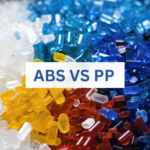High-density polyethylene, often abbreviated as HDPE, is a thermoplastic polymer derived from petroleum renowned for its exceptional strength-to-density ratio. It seamlessly combines lightweight attributes with exceptional durability, finding its utility across a wide range of applications, from everyday consumer products to pivotal industrial uses.
When you pause to consider it, HDPE silently assumes a pivotal role in your daily routine, from the moment you wake up until you retire for the night. Yet, the enigmatic nature of HDPE leaves us wondering: What precisely is it, and what grants it such indispensability? Let’s embark on a journey into the realm of HDPE to unveil its mysteries, explore its myriad uses, and appreciate its profound impact on our lives.
Table of Contents
What is HDPE: High-Density Polyethylene?
High-Density Polyethylene, or HDPE, is renowned for its exceptional flexibility and is a polymer with a unique combination of properties, including durability, chemical resistance, and eco-friendliness. HDPE plastic sheet is widely used in various industries for applications ranging from packaging materials to water management systems and outdoor furniture. Its waterproof nature, environmental friendliness, and safety for use in drinking water applications make it a standout choice in the world of plastics.
| Characteristics | Properties | Grades | Options Available |
|
1. High Density 2. Chemical Resistance 3. Durable 4. Flexible 5. Lightweight 6. Recyclable |
1. Density: 961 kg/ 2. Melting Point: 131.8 °C 3. Thermal conductivity: 0.54 W/m.°C. At °C. 4. Temperature of crystallisation: 121.9 °C. 5. Specific heat capacity: 1331 to 2400 J/kg-K 6. Specific heat (solid): 2.9 kJ/kg. °C. 7. Crystallinity: 61 % |
1. UV Resistant 2. Coastal Board 3. FDA Compliant 4. Cutting Board 5. Pipe Grade 6. Multi-Color Engravable 7. Playground Board |
COLOUR: Natural, green, black, red, yellow, beige, and more. TEXTURE, SURFACE, PATTERN
|
Manufacturing Process of HDPE Sheet
HDPE, or High-Density Polyethylene, is a robust plastic created from raw material – ethylene, with catalysts like Ziegler-Natta or metallocene used to tailor its properties. Obtained from crude oil or natural gas, the production involves high-pressure and high-temperature polymerisation, forming strong plastic chains.
Quality-controlled HDPE pellets are then shipped to manufacturers who use them in diverse applications, including packaging and construction. HDPE products find utility in numerous market sectors, encompassing hotels, resorts, colleges and universities, food service, retail, golf courses, municipal parks, and public venues.
HDPE vs. Other Plastics
HDPE is often compared to other plastics, and it stands out in several aspects:
- HDPE vs. Low-Density Polyethylene (LDPE): HDPE is more rigid and has a higher melting point than LDPE, which, in contrast, possesses lower tensile strength, heat deflection temperature, and melting point, rendering it a versatile choice for a wider array of applications.
- HDPE vs. Polyvinyl Chloride (PVC): Unlike PVC, HDPE is chlorine-free, establishing it as an environmentally conscious option. Furthermore, it boasts enhanced flexibility and a heightened capacity for withstanding chemical exposure.
- HDPE vs. Polypropylene (PP): HDPE exhibits superior chemical and impact resistance compared to PP, which is generally less flexible. In contrast, PP is stiffer and is commonly employed in scenarios demanding high heat resistance.
HDPE Plastic Applications: What is it used for?
The Power of HDPE in Everyday Life
1. Packaging Perfection
In the world of packaging, HDPE is a star player. It’s widely used for creating plastic bottles, food and beverage containers, and caps for a variety of products, from detergents to beverages. Its remarkable resistance to chemical oxidation, coupled with its weightless and shatterproof nature, ensures your goods remain safe and your packaging eco-friendly.
2. Piping Innovation
The plumbing and water distribution sectors highly rely on HDPE pipes. The HDPE product’s corrosion resistance, coupled with its flexibility, makes it the perfect choice for water supply, irrigation, and sewage systems. HDPE pipes are easy to install and require minimal maintenance, ensuring a long-lasting and efficient solution for fluid conveyance.
3. Environmental Guardian
For environmentalists and conservationists, HDPE offers a sustainable solution. The HDPE material is frequently used in manufacturing recycled plastic lumber, which is an eco-friendly alternative to traditional wood. This innovative use of HDPE helps in reducing deforestation and conserving our natural resources.
4. Playground Safety
HDPE takes the lead in crafting safe and durable playground equipment designed for outdoor applications. From slides to swing seats, its high impact resistance ensures that kids can have fun without worry. HDPE is also UV-resistant, effectively safeguarding playground equipment from the sun’s harmful rays and ensuring long-lasting quality in outdoor settings.

HDPE in Industrial Applications
5. Corrosion-Resistant Containers
In the chemical and industrial sectors, HDPE tanks are the preferred choice for their exceptional resistance to chemical corrosion and their suitability for the fabrication of secure environments for storing aggressive chemicals and hazardous materials. These tanks, specifically designed for enduring even the most severe conditions, assure both safety and long-lasting functionality in the fabrication of water tanks and chemical tanks.
6. Marine Marvel
HDPE’s remarkable water resistance has a significant impact on the marine industry, particularly in crafting boat docks and pontoons. Its resistance to rot, rust, and aquatic organisms makes it the perfect choice for water-contact structures, ensuring longevity, low maintenance, and minimal environmental impact.
7. Agricultural Advantage
In agriculture, HDPE shines, primarily in irrigation systems. Its flexibility and resistance to soil and moisture make it ideal for efficient and enduring irrigation solutions. HDPE’s capacity to adapt to varying terrains and resist oxidation reduces maintenance, while its use in greenhouse construction supports controlled cultivation with durability and conducive conditions for plant growth.
Summing Up!
HDPE stands as a testament to human ingenuity and innovation, serving as a marvel of contemporary material science that has profoundly impacted various sectors and our daily lives. Its unique blend of longevity, versatility, and sustainability firmly establishes it as an essential player in the realm of plastics.
Whether it’s life-saving medical equipment, eco-conscious packaging, sturdy underground pipes, or vibrant playground structures in our communities, HDPE consistently demonstrates its multifaceted potential. If you’re eager to dive into the limitless opportunities and benefits that HDPE offers or if you have any other inquiries related to plastics, Anyshapeplastic is your go-to destination.
Armed with a wealth of expertise, an unwavering commitment to quality, and a penchant for innovative solutions, we are fully prepared to assist you. Get in touch with us now and witness your ideas spring to life under the skilful guidance of professionals who genuinely understand the formidable potential of HDPE.
Frequently Asked Questions
1. What are some everyday products made from HDPE?
HDPE is present in a diverse array of items, spanning from milk jugs and chemical containers to garbage bags and plastic playthings. Moreover, it finds use in larger-scale applications, such as water and gas pipelines. It is even utilised in more intricate products like wood-plastic composites, 3D printing filaments, and components employed in reconstructive surgery for both skeletal and facial purposes.
2. Can HDPE be moulded into complex shapes and designs?
HDPE is a highly adaptable material that can be easily welded to fabricate complex and intricate shapes. This unique property of HDPE makes it an excellent choice for creating custom vessels, as well as for designing and building artistic installations with unique shapes and dimensions.
3. What is the weakness of HDPE?
While HDPE boasts many advantages, it also has some weaknesses. One of the notable weaknesses is its susceptibility to deformation at high temperatures. When exposed to excessive heat, HDPE can soften and lose its shape, making it less suitable for high-temperature applications.
4. How can HDPE be recycled, and is it cost-effective?
Recycling HDPE is a financially feasible process involving the collection, cleaning, melting, and subsequent reprocessing of the plastic into fresh products. HDPE is frequently recycled and is identifiable by the resin code “2” for easy recognition.









